Hi everyone!
Today I would like to take you to the Celtic Otherworld at the foot of the magical Kulm near Weiz in Styria, Austria, on a journey through more than 4000 years, Styrian prehistoric comes to life in ten primeval huts (reconstructions), populated by “primeval people”.
In the Celtic village of Kulm you can see life in earlier times. Reconstructed houses with a wall plaster made of clay and chaff mixture with thatched roof and clay floor that you can no longer imagine in today's life.
HISTORY AND BUILDINGS
In the late Urnfield period, from around 1000 to 700 BC. BC, Celtic settlers built more and more hamlets in the Styrian foothills of the Alps due to a favorable climate. On the summit of the Kulm they erected buildings, presumably post-and-beam structures with wattled walls plastered with clay, on terraces of houses that were knocked out of the stone floor. The various types of house from more than 4000 years of settlement history on and around the Kulm (from the Stone Age to the Celtic Age) were recreated in 1999 in a palisade-reinforced prehistoric village (ten reconstruction buildings furnished with figures)
Important earlier buildings, which we no longer know today:
- The Cult Hill
- a granary
- the baking hut from the Hallstatt period
Entrance to the otherworld



a fountain



the Celtic housemates





left, archaeological finds from the Celtic period, midst, East Neuric coin finds from Kulm and Celtic nobles (around 200 BC), on the right a druid.
Roman historians report that the white-robed priests of the Celts (Druids) were revered and feared. Their training in scientific schools lasted up to twenty years, during which they were trained to become physicians (natural healers), priests, mathematicians, AS tromons, scribes and rhetoricians.
They could calculate calendar dates, establish contact between gods and humans, predict the future and give political advice to kings.
In addition, they are said to perform shamanic transformations into animal forms, weather magic and incantations through songs and harp music.

Why the druid knowledge was lost
All the wisdom of the druids, especially the religious ideas and rites, were only passed on orally to initiates.
Only primeval religious figures such as the earth (mother) goddess DANA, the sky god LUG, the light god BELEN, the vegetation (dead) god ESUS, the wheel (thunder) god TARANIS, the lord of the animals CERNUNNOS and the tribe (war) - God TEUTATES are outstanding in writing from the mass of Celtic gods' name.
The SACRIFICES (plants, animals and humans) under the direction of druids did not originally take place in temples but in sacred groves.
Her UNIVERSAL HEALING PLANT was MISTLETOE. They also knew sacred trees and shrubs such as the yew, rowan, oak, birch and hazel.

Festivals of the Celts
IMBOLC Festival February 1, purification festival in honor of the fire goddess BRIGID, today before "Maria Candlemas"
BELTENE festival (beginning of the light half of the year) May 1st, spring festival, cattle drive, today the maypole is planted.
LUGNASAD festival (main festival of the year) August 1st, beginning of harvest, marriage of the god of heaven with the earth.
SAMUIN Festival (beginning of the dark half of the year) November 1st. End of the year, night of the underground, tonight before the festival of the "poor souls"

Largest settlement area of the Celts

Stone Age hut of the Lasinja culture (around 400 BC)
Post-and-beam construction with rod walls plastered with clay, saddle roof covered with reeds, apotropaic cattle head on the west gable.


- Sleeping area/fireplace with spark arrestor
- Seated woman stomps grains
- Jumping hunters after a successful hunt
- Mother with baby and toddler


Cult Hill, Viewpoint
Erected in 1999, the year of the great solar eclipse.
Furnishing:
East side (Kingdom of the Living) Solstice Stakes
West side (realm of the dead) skulls of sacrificial animals and stone head of a Celtic hero
Ribbon enclosure of the sacral square


Hallstatt House (around 800 BC)
Block construction made of fully combed round trunks, projecting gable roof to the west with stepped thatched roof


Baking hut of the Hallstatt period
Pit house with thatched roof made of round logs
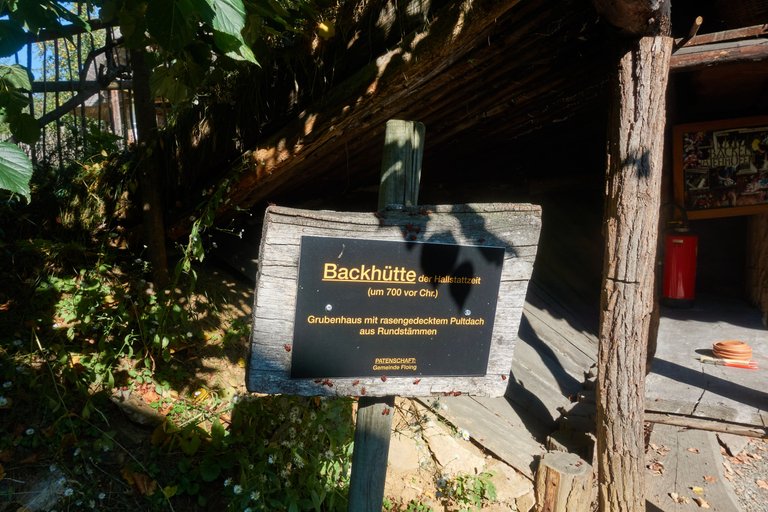




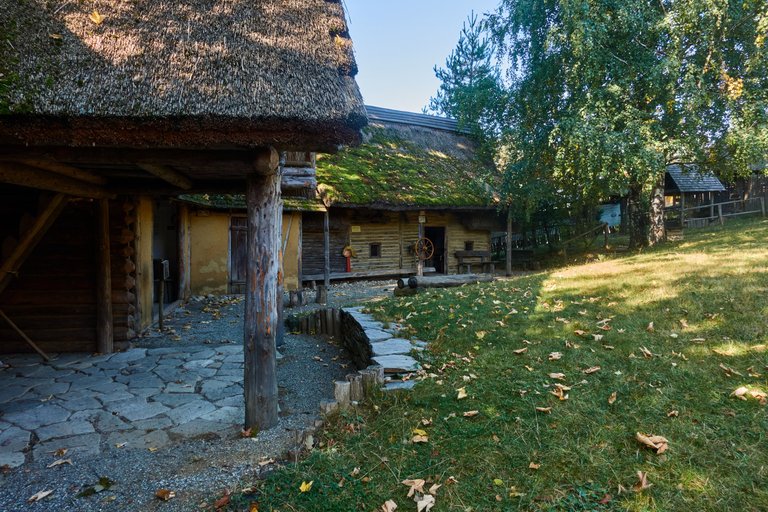

Celtic weapon finds from the Kulm fortress
Iron weapons from the 4th to 3rd centuries BC, recovered from three battlefields within the oppidum around 30 years ago, prove that the Kulm summit must have been fiercely fought over at the time the Celts conquered the land.
Description from left to right:
Guard plate with roof-shaped central ridge, tip broken off in battle.
Curly guard plate, triangular central ridge, edges badly damaged.
Guard plate with a curved triangular central ridge, the point deformed in battle.
Socket ax, the socket edge and the cutting edge knocked out in battle.
shield boss
with a roof-shaped central ridge and bulging edges, fixing plates chipped off on both sides, hump section cut through.
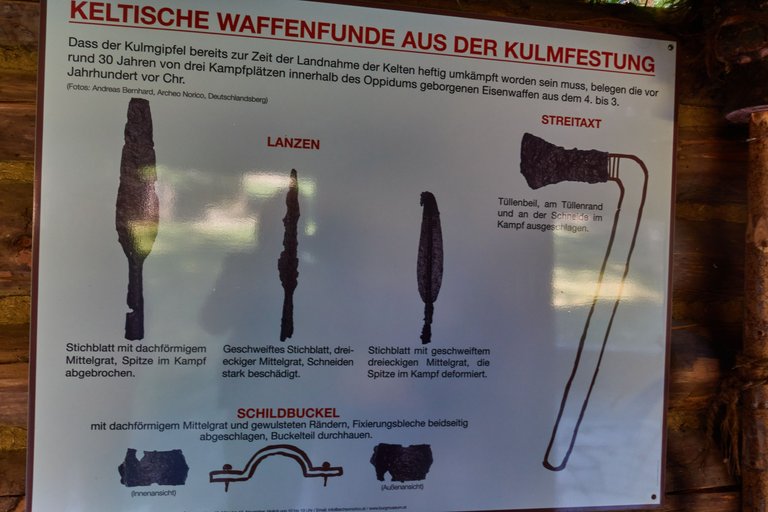
The defenders of the Kulm summit at the beginning of the 1st century BC:
- Schleuderer
- Schwertkämpfer
- Bogenschützen

Inventions of the Celts
- ploughshare
- spoke wheel
- hand mill
- beer
- wooden barrel
- scythe


- Brick hearth/spark cap/hanging cauldron
- Cooking pots on a tripod/fire horse/plate shelf
- Wood fireplace/Wreath of smoke/Wooden vats
- Table with surrounding benches



Around the Celtic village




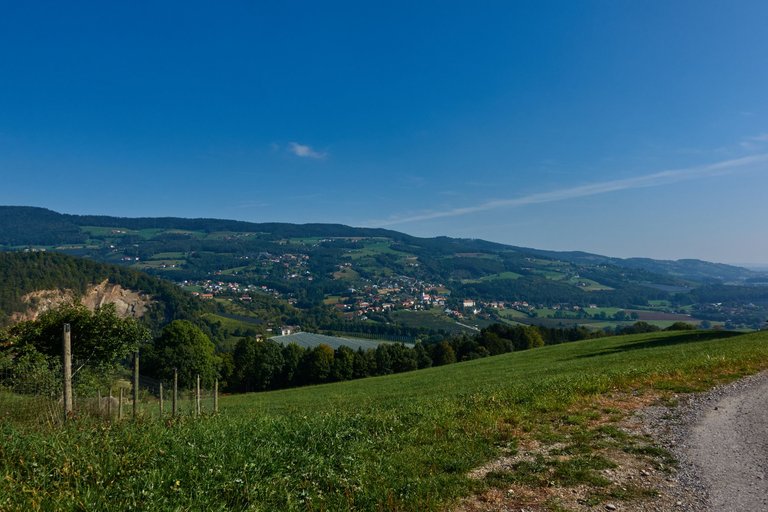

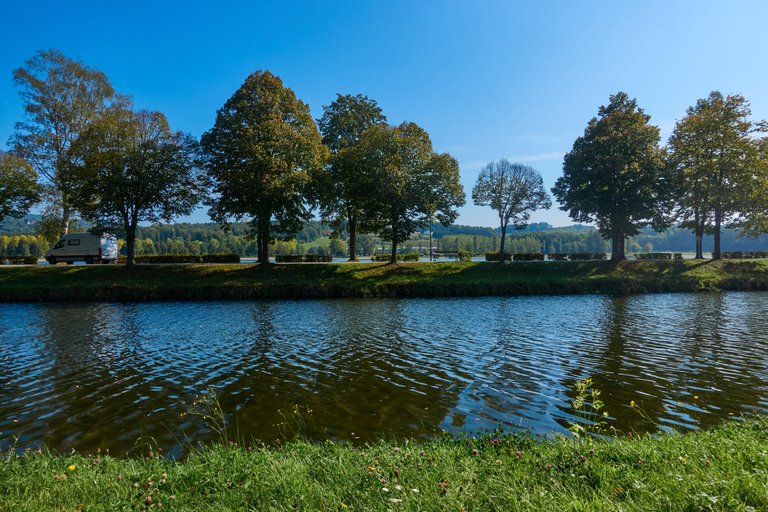

Congratulations, your post has been added to Pinmapple! 🎉🥳🍍
Did you know you have your own profile map?
And every post has their own map too!
Want to have your post on the map too?
tank you.
WOW you really took us for a walk back in time such an interesting place, to see how life was back then
the scenery in the area is beautiful as well
Thanks for joining Wednesday Walk :), I truly enjoy exploring the world virtually each Wednesday seeing walks from all around the globe and feeling I am there and experiencing it all myself, such as I did in your post just now :)
Thank you very much, I am glad that you like this excursion, yes you are right, it is very interesting how people lived back then.
Daily Travel Digest #1484.
Become part of our travel community:
- Join our Discord
- Learn more about our travel application
Hiya, @ybanezkim26 here, just swinging by to let you know that this post made it into our Honorable Mentions in Your post has been manually curated by the @pinmapple team. If you like what we're doing, please drop by to check out all the rest of today's great posts and consider supporting other authors like yourself and us so we can keep the project going!Congratulations @proanima! You have completed the following achievement on the Hive blockchain and have been rewarded with new badge(s):
Your next target is to reach 3500 replies.
You can view your badges on your board and compare yourself to others in the Ranking
If you no longer want to receive notifications, reply to this comment with the word
STOPCheck out the last post from @hivebuzz:
thank you!
Wow what a fascinating walk you went on through this extraordinary period of ancient life.
I have bookmarked you post to read again later to take in more detail (I have droopy eyes now sorry...)
Thank you so much for sharing this and I can't wait to read it again soon!
Take care and speak soon.
Thank you very much, I am glad that you like my post and I wish you all the best😊